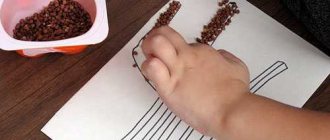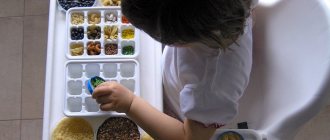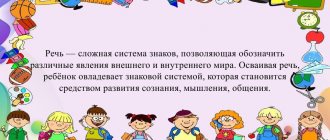If the baby's fine motor skills are constrained, in most cases there will be deviations in speech. In this case, the likelihood of delays in speech development increases significantly.
Child psychologists, together with speech therapists, have discovered that subtle movements of the hands and fingers affect speech development. When there are no disturbances or any delays in the development of finger movements, the speech apparatus develops according to the standards established by specialists.
Developed fine motor skills in children contribute to the development of speech.
What unites motor skills and speech development?
Throughout evolution, people actively used gestures to communicate with each other. Gradually loud shouts were added to this. With the evolutionary development of man, finger movements became more complex and improved. The baby’s speech starts in a similar way. Scientists have proven that motor and speech functions are interconnected. They cannot occur separately from each other. First, finger movements and manipulation of the hands begin to develop, and after this the formation of speech begins. Nowadays, child psychology and speech therapy consider fine motor skills as the ability to perform precise manipulations of the fingers and hands, as well as the coordination of these movements with each other. The word dexterity is often used to refer to the ability to make fine, small movements with the fingers. The child must be able to make movements of varying complexity - from the ability to pick up a toy to the ability to write letters and draw simple pictures. The gradual complication of fine motor skills in preschool children affects the overall development of the child’s intelligence. They are present even in a newborn, and as they grow older they only improve and become more complex. New skills performed with fingers appear.
Small children can grasp objects with their entire palm. After some time, they are able to perform operations with the thumb and forefinger (the so-called “pincer grip”). Gradually, they learn to hold a spoon, fork, pencil, and other small objects that they encounter in everyday life. The development of fine motor skills has another important feature. It is connected to the baby’s central nervous system and has a great influence on his ability to concentrate. There is a direct connection between the ability to make small movements with the fingers and the ability to quickly remember objects, their names, and features. As you know, the human brain consists of separate centers responsible for one or another activity. The speech center is located close to the area responsible for hand motor skills, so they mutually influence each other. The development of one of these departments is impossible without the parallel development of the other. By stimulating the development of finger movement skills, the speech center begins to work. That is why, when starting the baby’s speech, it is necessary to devote time to the development of small, precise movements with the fingers. Fine motor skills are the key to success in educational institutions. The development of a child’s motor skills is used to judge his readiness for school. If there are no problems with motor skills, then he is able to learn to write and has a sufficient level of general intelligence and its acuity. Able to quickly perceive and remember information, has developed logical thinking for his age.
Consultation for parents “How to develop fine motor skills in children 3–4 years old”
Lisenkova Tatyana Ivanovna
Consultation for parents “How to develop fine motor skills in children 3–4 years old”
How to develop fine motor skills in children 3-4 years old
A pressing problem in our time is the full development of children from preschool age. An important role in the success of a child’s intellectual and psychophysical development is the formation of fine motor skills .
Fine motor skills of the hands interact with such higher mental functions and properties of consciousness as attention, thinking, optical-spatial perception (coordination, imagination, observation, visual and motor memory, speech. The development of fine motor skills is also important because the entire future life of the child will require the use of precise, coordinated movements of the hands and fingers, which are necessary to dress, draw and write, as well as perform a wide variety of everyday and educational activities.
A child's thinking is at his fingertips. What does it mean? Research has proven that the development of speech and thinking is closely related to the development of fine motor skills . A child's hands are his eyes. After all, a child thinks with feelings - what he feels is what he imagines. You can do a lot with your hands - play, draw, examine, sculpt, build, hug, etc. And the better motor skills are developed , the faster a 3-4 year old child adapts to the world around him!
Scientists who study the activity of the children's brain, the psyche of children , note that the level of development of children's speech is directly dependent on the degree of development of fine movements of the fingers.
To develop fine motor skills, you can use various games and exercises.
1. Finger games are a unique means for developing a child’s fine motor skills and speech in their unity and interconnection. Learning texts using “finger”
Gymnastics stimulates
the development of speech , spatial thinking, attention, imagination, fosters reaction speed and emotional expressiveness.
The child remembers poetic texts better; his speech becomes more expressive. 2. Origami - designing from paper - is another way to develop fine motor skills in a child , which, moreover, can also become a truly interesting family hobby.
3. Lacing is the next type of toy that develops hand motor skills in children .
4. Games with sand, cereals, beads and other bulk materials - they can be strung on a thin cord or fishing line (pasta, beads, sprinkled with palms or transferred with fingers from one container to another, poured into a plastic bottle with a narrow neck, etc.
In addition, to develop fine motor skills you can use:
• playing with clay, plasticine or dough. Children's hands work hard with such materials, performing various manipulations with them - rolling, crushing, pinching, smearing, etc.
• drawing with pencils. It is pencils, not paints or felt-tip pens, that “force”
the muscles of the hand tense, make efforts to leave a mark on the paper - the child learns to regulate the pressure in order to draw a line of one thickness or another, coloring.
• mosaics, puzzles, construction sets - the educational effect of these toys cannot be underestimated.
fastening buttons, “Magic locks”
- play an important role for the fingers.
Systematic work in this direction allows you to achieve the following positive results: the hand acquires good mobility, flexibility, stiffness of movements disappears, pressure changes, which in the future helps children easily master the skill of writing
All mothers know that children need to develop fine motor skills . But not everyone knows how to do it correctly, and what is fine motor skills and what features does it have? What activities, games and exercises should be carried out with children to develop motor skills ? Let us consider all these questions in detail.
General concept and features of children's fine motor skills
Fine motor skills are the ability to perform small and precise movements of the hands and fingers and toes as a result of the coordinated actions of the most important systems: nervous, muscular and skeletal. refer to the motor skills of the hands and fingers. The area of fine motor skills includes a wide variety of movements: from simple gestures (for example, grabbing a toy)
to very complex movements
(for example, writing and drawing)
.
The development of fine motor skills plays an important role in the overall development of a child . Fine motor skills develop from newborns. First, the baby examines his hands, then learns to control them. First, he takes objects with his entire palm, then with only two (thumb and index)
fingers. Then the child is taught to hold a spoon, pencil, and brush correctly.
Fine motor skills have a very important feature. It is associated with the nervous system, vision, attention, memory and perception of the child. Scientists have also proven that the development of fine motor skills and speech development are very closely related. And this can be explained very simply. In the brain, the speech and motor centers are located very close to each other. Therefore, when the motor skills of the fingers are stimulated, the speech center begins to activate. That is why for the timely development of a child’s speech, it is necessary to pay great attention to the development of fine motor skills . Fine motor skills directly affect manual dexterity, handwriting, which will be formed in the future, and the child’s reaction speed.
Based on the characteristics of the development of a child’s fine motor skills, his readiness to study in a school institution is subsequently judged. If everything is in order, then the child is prepared to learn to write, can think and reason logically, has good memory, concentration, attention and imagination, and coherent speech.
Fine motor skills develop gradually , this is an individual process and each child goes through it at his own pace. At first, the baby’s movements are awkward, inept and inharmonious. To help your baby improve fine motor skills , you need to play educational games (in the online magazine “ Development ”
There are articles about
educational games for children aged 1 year , as well as games for the development of children aged 2 years ).
Activities, games and exercises to develop fine motor skills
There are many activities, games and exercises for developing fine motor skills . They can be divided into the following groups: finger games, games with small objects , modeling and drawing, finger massage. Articles about development according to the Montessori system and also about Monessori games will also be of interest.
Let's look at the simplest and most effective games:
1. Palm massage
This is the simplest and most universal way for any age to develop fine motor skills . Run your finger over the baby's palms, stroke them and massage them. Accompany your actions with the saying “Magpie-Crow”
.
2. Ladushki
Everyone has known the nursery rhyme “Okay, okay”
. This game will teach little ones to straighten their fingers and clap their hands.
3. Paper tearing
This exercise is suitable for children from 7 months. Give your baby several sheets of soft colored paper. He will feel it with pleasure, begin to twirl it in his hands and tear it. This activity will give him unspeakable pleasure.
4. Turning pages
After a year, tearing paper can be replaced by flipping through the pages of a picture book or magazine.
5. Beads
Children like to sort through small objects , which is very useful. Therefore, you can wear some necklaces with beads of various sizes and shapes. The child will finger them with joy and interest.
6. Insert bowls
You can build turrets from them and nest them inside each other. This game develops a child’s understanding of the size of objects.
7. Cereals
Pour any cereal into a bowl and give it to your baby. He will touch the cereal with his hand or spill it through his fingers. This game develops fine motor skills and tactile sensations well.
8. Jars of cereals
Pour different cereals into jars and let your child put his hand in each jar one by one. This way he can feel the different grains and pick them up with his fingers. You can make the task more difficult. In front of the child's eyes, bury some small object in the cereal and give him the jar. Let him try to find this item.
9. Drawing in the sand
Place sand on the tray. Take the child's finger in your hand and run it across the sand. You can start with simple shapes - lines, rectangles, circles, gradually complicating the task.
Toys for developing fine motor skills
10. Pea
You will need a pea and a jar with a removable lid. Show your child that first you need to remove the lid, then take the pea with your fingers and put it in the jar, then close the lid. Ask your child to do the same steps. Don't be discouraged if it doesn't work out the first time. Show your baby the entire chain of actions slowly several times and then he will definitely be able to repeat everything. Active children quickly get bored with this game, in which case there is no need to force them. Offer your child a different game.
11. Screwing caps
Something as simple as screwing and unscrewing the lids of jars, bottles, and bottles develops finger dexterity . Offer your baby vessels of different sizes and shapes, this will make the game more varied.
12. Fastening, unfastening and lacing
This exercise does not require any additional toys. Gradually include your child in the dressing process. Let him button and unfasten his own buttons and zippers. This will not only develop hand movements, but also teach the child to be independent. Also give your child some unnecessary lace-up shoes, which will become an excellent hand exerciser.
13. Modeling
Modeling is suitable for children of all ages . Plasticine, clay, and dough are suitable for modeling. When you are going to bake something, be sure to invite your child with you. He will really enjoy kneading and rolling out the dough. Besides, he will be proud that he is helping his mother.
Exercises to develop fine motor skills of the hands
14. Drawing and coloring
It is very useful to trace the outline of pictures consisting of dotted lines, as well as to color objects of various shapes. It is very useful to draw on vertical surfaces: a wall, a board, a mirror. Therefore, it is advisable to hang a special board for the baby so that he can draw.
15. Collecting mosaics and puzzles
For children under 3 years old, puzzles and mosaics with large parts are chosen. Puzzles also exercise your imagination.
16. Cutting
Buy children's scissors, a glue stick, colored paper and cardboard for your baby. Teach him how to make things. Cut out pictures, glue them, make snowflakes, etc. This will not only develop fine motor skills , but also spatial imagination and creative thinking.
However, it is worth remembering one simple thing. Games to develop fine motor skills should be done under adult supervision. Otherwise, the child may swallow some small part or choke on it. to play games and do exercises that develop fine motor skills systematically. Work with your child every day and you will soon notice that your baby’s movements become smoother, clearer and more coordinated each time.
How to develop motor skills in preschoolers
The development of fine motor skills in preschool children comes down to special games and special activities: drawing, mosaic or modeling. As you grow older, toys change and become more complex. Rattles are being replaced by creativity kits and construction sets consisting of small parts. The older a child gets, the more complex his or her entertainment and activities become. Experts have developed games that develop fine movements of the hands. The video below offers simple yet effective exercises.
Norms
The development of fine motor skills in children occurs gradually. By a certain age, a child must perform the following set of actions corresponding to the level of physiological and mental development:
- At 2-2.5 years old, the baby can unfasten Velcro and large buttons, push small objects into holes, remove clothespins, and draw in a sweeping manner. Masters simple finger gymnastics exercises.
- At 2.5 - 3 years old, he unscrews lids, draws with his fingers, sculpts Easter cakes, and copies lines. Knows how to string beads onto a rigid thread or wire, cut a sheet of paper, collect cereal with a spoon in a container and transfer it to another jar.
- At 3-3.5 years old, he draws straight lines, traces dotted lines, repeats simple figures based on a pencil model, sculpts balls and sausages from plasticine. Knows how to fasten and unfasten all types of zippers and buttons, performs finger gymnastics well, and is fluent in using scissors.
- At 4 years old, he holds a pencil correctly, draws hexagons, stars, and cuts out any geometric shapes. Knows how to sort small objects, unwrap wrappers, string small beads on a thread, sculpt figures from dough, plasticine, tie knots, repeat the contours of objects with a finger in the air.
- At the age of 5, he copies letters and numbers, folds paper several times, and draws a house. Can identify small objects by touch, lace up shoes, and catch a ball with two hands. In older preschool age, the development skills of fine motor skills in children consist in the fact that their hands and fingers are already formed for mastering writing.
- At the age of 6, a preschooler copies complex figures with a pencil, parts of the human body, catches a thrown object with one hand, and can perform a mirror image. He knows how to play a keyboard instrument, braids hair, and almost completely masters the motor skills of his hands by the 1st grade.
The development of skills in children 2-3 years old can take place individually, with minor deviations. Most often, they quickly catch up with their peers. If strong deviations from the norm are detected in the diagnosis, for example, 1-2 tasks out of 6 are performed correctly or averagely, we can talk about violations in the intellectual and physiological plane. Developmental correction is carried out by specialists; most often, children need one year of full-time lessons with a teacher to enter the age norm and eliminate delays in speech development.
If by the age of 3-4 years the child cannot hold a pencil correctly, does not fold a pyramid, does not hold a spoon or scissors in his hand, does not catch or throw a ball, then an urgent need to contact a specialist. These indicators indicate serious deviations in development and education.
Games with small objects
This toy for developing fine motor skills is easy to make with your own hands. Beads, buttons or cereals are suitable for activities. Such games for the development of fine motor skills have a tonic and healing effect on the child. For a positive effect, children perform certain manipulations with these objects. You can sort small objects by shape or size, or guess their name with your eyes closed.
You can also roll round objects, such as peas, between the thumb and index finger of different hands alternately. It is useful to press objects onto the table with each finger in turn, while trying to make rotational and rolling movements. These can be large balls of plasticine, walnuts, shells. Stringing on a string or fishing line develops motor skills well. To do this, you can use beads, pasta, buttons or any other suitable objects with a hole. Together with mom or dad, a child can make beads from cut out cardboard circles, leaves or dry berries. The child can also make letters or silhouettes of animals from seeds, twigs, and other small elements.
Classes with small objects are carried out under adult supervision. This is necessary for the safety of the child.
Card file of exercises and games with goals according to the Federal State Educational Standard
The card file of exercises according to federal standards includes the following types of classes:
- to relax your arms (hands);
- for the development of motor skills using an unsharpened hex pencil;
- for the development of motor skills using natural materials (cones);
- for the development of motor skills with the help of a prickly massage ball.
The first type includes the following exercises:
- "Fish" in the water;
- “Helicopter”, which involves winding thread around an elastic band or ball;
- “Hedgehog” with palms;
- “Hare and Fox” with quickly and slowly “walking” fingers;
- “A conversation between two”, involving interaction between several group members;
- “Flight of the Birds” with active hand work;
- “Track” with buttons sewn to the fabric;
- “Pebbles” with plasticine laid out in a straight line;
- “Watch” aimed at active movements of the hands;
- “Lock”, which includes movements of the fingers and hands;
- “Spider” - moving fingers along the wall;
- “Scissors” with cutting movements of the fingers;
- “Firefighter”, which involves running your fingers along a “ladder”;
- “Peck fingers” - connecting the thumb with the rest in turn.
The second type includes the following exercises:
- “Pencil rolling” using the palm of your hand;
- “Making fire” with rolling a pencil up and down between your hands;
- "Slide" with rolling a pencil up and down one hand using the other hand;
- “Spinner” with a pencil spinning on the table;
- “Helicopter” with a pencil spinning in the air;
- “Crane” with lifting an object with two fingers;
- “Excavator” with lifting a pencil with your finger;
- “Swing” with swinging a pencil with two connected fingers.
The third type includes the following exercises:
- “Twist the bump” using your palms;
- “Roll the bump” using your palms on the table;
- “Catch the cone” by throwing it from hand to hand.
The fourth type includes the following exercises:
- rolling an object back and forth on the table;
- rolling an object around the table in a circle;
- finger pressure;
- catching a thrown ball;
- pressing on the ball with both hands;
- moving the ball from hand to hand with acceleration.
Coloring pages on traffic rules for a preschooler 3-4 years old
Finger games and exercises
Finger exercises and games include many variations that require small and large objects of different types and densities. Paper, cereals, bulk and small items are suitable for this.
Important! It is best to accompany lessons with sayings in poetic form. Thanks to this, children will develop their speech apparatus and memory.
Many of the exercises will be useful to the baby in the future (for example, the ability to tie shoelaces, fasten buttons).
Finger drawings
Finger drawings as an element of classes are recommended to be done before lunch. During this period, children are especially active. At first, it is worth conducting a lesson for a couple of minutes, gradually increasing the time to 20 minutes without breaks.
For classes you need to purchase special paints, sold in any store. They have a special consistency that does not require adding water. The lid should fit tightly to the jar.
The sheets you choose should be A3 format so that the child can safely draw and the colors are bright. The presence of “CE” on the box means that the product meets world-class standards.
Massage of palms and fingers
Massage is a key point in the development of children's motor skills. The massage includes stroking the arms from fingers to palms, including the hands. Classes are accompanied by tongue twisters and poems.
Finger massage
Note! Before the massage, you need to warm up the baby's hands. The duration of the procedure should not be more than 5 minutes. Massage should be done for 10 days once a month.
Sand exercises
The plasticity of sand makes him want to create miniatures from this material that he saw in the real world. Such paintings are a product of a child’s creativity; they are the fruit of his wild childhood imagination. The main emphasis should be on the child’s creative self-realization. Thanks to useful entertainment, you get rid of internal tension; this happens on an unconscious level. To conduct classes at home, you need to find a large box or other container. Fill it halfway with clean, dry sand. Show your baby an object (toy), which then needs to be hidden in the sand. Gradually, day after day, the number of these toys can make the fun more difficult. You can also ask your child to draw a miniature of the zoo, forest or park in the sand where you walk. The kid must independently choose the items with which he will make such a model in the mini-sandbox.
Massage of palms and fingers with natural materials
For children 4 years old, you can offer a massage using pine, spruce, cedar cones, walnuts, and hazelnuts.
1. “Twist the cone”
Take a pine cone and place it between your baby's palms. Ask your child to spin the pine cone (like a wheel) in different directions for about 2-3 minutes.
2. “Roll the bump”
First, the exercise is performed with one spruce cone, then with two. Rotate the pine cones between your palms for 1-3 minutes.
3. “Catch the bump”
Take any pine cone. Ask your child to throw it up with both hands, and then catch it with both hands. After the baby masters this exercise, you can complicate it: toss and catch the pine cone with one hand; throw a cone with your right hand and catch it with your left - and vice versa. The duration of the exercise is 2 minutes.
4. “Walnut”
Roll the nut over the palm of your right hand, then over the back of your left hand. The duration of the exercise is approximately 3 minutes.
5. “Pour in the nuts”
Place a handful of hazelnuts from one hand to the other. The duration of the exercise is 1-2 minutes.
6. “Nuts on a tray”
Place a handful of hazelnuts on a tray. Roll the nuts with your palms and the backs of your hands. The duration of the exercise is 1-2 minutes.
7. “Grains”
Here you can use a variety of grains: buckwheat, rice, millet, etc. And the exercises can also be very different: squeeze the grains in a fist, pour them from one hand to the other, mix in a deep bowl, etc. The duration of each exercise is 3 minutes.
8. “Tender Feather”
Run the pen over the surface of the palms and back of the child's hands. The duration of the exercise is 3 minutes.
Various finger games
Such games are a popular, accessible, and most importantly effective method that has a positive effect on the development and complication of small movements of the hands and fingers. They do not require special preparation and do not require studying a large amount of didactic material. Exercises for developing fine motor skills do not require special conditions. They can be carried out anywhere - at home, standing in line at the clinic or traveling on public transport. It is very useful to reinforce such activities by reading poems and singing children's songs. The following toys for the development of fine motor skills are suitable for preschoolers of the younger group:
- cubes;
- pyramids;
- balloons;
- small soft toys;
- mosaic elements or puzzle pieces.
These items can be used to make turrets or any other complex figures. These “buildings” must be sustainable. The main thing is that they do not fall apart at the slightest touch. During the game, the adult must ensure that the child does not get tired and that his fingers have time to relax. Otherwise, the games will become uninteresting for the baby. To prevent your child from getting bored during classes, alternate these activities with each other, spending 7-10 minutes on each.
Exercises to develop fine motor skills for children over 2 years old
1. “Fisherman”
Pour water into a bowl and throw in several small objects: pieces of cork, twigs, large beads, etc. Invite your baby, using a small sieve tied to a stick, to catch all these objects in turn and put them on a plate on the tray on the right from the bowl. The baby should hold the “fishing rod” with one hand.
2. “Track”
Make a path 3-5 cm wide on the table, bounded on both sides by strips of paper. Invite your child to sprinkle it with semolina or millet. You need to pick up the cereal with three fingers and try not to spill it over the edges of the path.
3. “Magic Spoon”
Place two cups on the tray: on the left is a cup with cereal, and on the right is empty. Moving your child's hand, show him how to take the cereal with a spoon. Carefully bring the spoon to the empty cup and tip it over it. Task: pour all the cereal from the left cup to the right one.
4. “Sweet tea”
Your baby can already add sugar to his tea on his own. Now teach him to stir sugar in a mug.
5. “Salute”
The child takes small pieces of colored paper and tries to tear them as small as possible. He places the torn pieces on a saucer. Then you need to take all the pieces in your palms and throw them up.
6. “Make a lump”
Give your child a piece of paper. His task: to crumple the leaf so as to form a dense lump.
7. “Spyglass”
The child takes a sheet of A4 paper and rolls it into a tube with both hands, after which he brings the tube to his eye and examines surrounding objects through it.
8. “Collect the sticks”
Scatter the counting sticks in front of the child. The kid must collect them all one by one back into the box.
Where to start developing fine motor skills in young children
The early age of the baby is the period from one to three years. This is the perfect time to start developing your baby's motor skills and speech. This period of time has the peculiarity that the baby’s hands are the main tool for exploring the surrounding space. It is extremely important for the baby to touch the object and begin to interact with it by touch. An adult must name the object, tell in detail about its shape and color. If the baby is developing correctly, he should make a lot of movements with his hands. Gradually, these “gropings” become more accurate and coordinated. To start developing their baby, parents should do simple exercises to develop fine motor skills:
- teach children to play with small toys;
- manipulate objects (throw, place on top of each other, wrap, turn over, crumple, straighten);
- make attempts to fasten buttons;
- tie your shoelaces;
- pour water from one bottle to another;
- eat independently with a spoon;
- wash your hands yourself;
- brush your teeth.
Child development specialists have developed many special games that effectively influence motor skills and, in an indirect way, trigger speech skills. Parents choosing such games should pay attention to the age-appropriate complexity of these games. There are several main games that promote motor development.
Palm massage
This is a very simple, and most importantly universal method that is suitable for preschoolers of any age. You need to slowly move your finger over your palms, stroke them or massage them. It is better to accompany all actions with funny nursery rhymes.
Okay game
It is difficult to find a person who does not know this nursery rhyme. “Ladushki” will teach the little one to make simple movements - bend and straighten his fingers, clap his hands.
A simple game will help develop your child's motor skills.
Tearing sheets of paper
It is better to do this exercise with children older than 7 months. You need to give the baby one or a couple of sheets of paper, preferably colored. The baby will begin to feel it, twirl it in his hands, crush it or tear off pieces.
Flips through the pages of books
For one-year-old babies, it is advisable to replace tearing pages with flipping through them. children's books, colorful interesting magazines. The main thing is that the books themselves are interesting to the child.
Playing with beads
Many children enjoy sorting or sorting through small objects. Mom can put on some bright colored beads, with beads of various sizes and shapes. They will awaken the baby's interest, and he will play with them with pleasure.
Let's do crafts together
For parents of preschoolers and younger schoolchildren, homework in the form of crafts is like a bad dream. But such activities with a child perfectly develop motor skills and train fingers. Don’t be lazy, make a beautiful craft with your child at least once a week. For a child, this is an excellent training for fine motor skills and development of imagination.
Developing fine motor skills
The following activities are used for children of primary preschool age.
Massage
Self-massage and adult assistance are used. Carry out 2 times a day, use it as a warm-up before drawing or sculpting. The set of exercises includes:
- Kneading the palms and hands.
- Immersion of palms in a dry pool with gritty sand, plastic bottle caps, etc.
- Use of devices: hedgehogs, finger rings, marlbs.
Palm massage should be done with elastic movements, rubbing the skin until red. You can use improvised means, for example, a pencil, nuts. In the first lesson, teach preschoolers the correct massaging movements so that he can apply the necessary amount of force to knead his hands.
The nut is rolled between the palms and held by weight along the edges. The pencil is inserted between the fingers and fixed in a certain position.
The following exercises for self-massage are suitable for children aged 3-5 years:
- Clothespin Warm up your fingertips using a clothespin. The skin is bitten with light but noticeable movements. The clothespin seems to bite. Be sure to carry out the procedure on both handles.
- Warm-up with Su-Jok These are special balls with spikes for developing fine motor skills of the hands. Exercise improves blood flow, warms up and trains muscles. Children roll them across their palms from top to bottom.
It is important not to forget about protecting your health; the skin of your hands and fingers should be clean, without scratches, and prepared for massage.
Finger games
Necessary for the development of speech and coordination of movements, warming up the muscles of the palms and phalanges.
- Legs
Fingers make walking movements on the table
- Glasses
Children pretend to be wearing glasses with their fingers, forming circles with their thumb and index finger. Bring them to your eyes.
- Let's go for mushrooms
We count our fingers: one, two, three, etc. We bend each finger in turn, reciting a poem about how our fingers were looking for mushrooms, without unclenching our fist.
- Chair and table
We depict a table with a fist and a palm, change the position of the hands one by one. Then a chair: bring your open palm to your fist, place it on one side of the fist.
- boat
The verse is used: A little fox floats in a boat (palms are folded in the shape of a boat), a little hare calls in a boat (the kids wave, calling for a friend).
- Scissors
The child imitates scissors with his fingers and makes characteristic movements, as if cutting fabric.
Finger paint
The development of fine motor skills occurs faster through visual activities. Use modern drawing methods and materials. One of them is finger paints.
Draw figures, landscapes, large compositions based on a model or fantasy. With a 1-2 year old child, draw lines and circles. With children from 3-4 years old - animals, houses, cars, geometric shapes.
To work with older preschoolers, print out complex samples for drawings, with the need to use a large number of shades, depicting polygons, numbers, and letters.
Application
A fun method for teaching children of all ages. Children from 4-5 years old are already cutting out figures of large and small sizes. They know how to glue paper to cardboard and place elements of a work on a sheet of paper.
Use designs with small details for appliqués. For example, an autumn tree with many small leaves on the crown, or an applique in the shape of a fish, where you need to cut out each scale separately.
Suitable materials include colored paper, napkins, corrugated cardboard, and natural remedies (sticks, pebbles, sand, cereals).
Rolled napkins make great flowers. The material can not only be rolled into balls, but also torn into pieces, gluing the pieces on top of each other.
You can make a sheep from colored rice and semolina. The outline of a sheep is drawn on a sheet, it is covered with PVA glue, then semolina is sprinkled on the body, and the legs and horns are made of rice.
Modeling
For classes, plasticine of varying hardness, dough, and kinetic sand are used.
Soft plasticine is suitable for children aged 2-4 years. They need to be taught how to roll sausages, balls, and construct simple shapes by attaching them to cardboard.
Older children can already perform complex tasks. For example, a picture made from plasticine in different ways.
Use the smudge and build method. Be sure to clearly show your child how the parts are connected, how to make small parts and use colored elements.
During classes, not only motor skills develop, but also the child’s creative potential, his horizons and knowledge about color, shape, size, and texture of materials expand. Visual activity develops the skill of perseverance and determination.
Theoretical aspects of conducting classes on the development of fine motor skills in preschool educational institutions
One of the problems caused by the deteriorating environmental situation on our planet has been the increase in the number of children with various speech development disorders. Currently, this figure has exceeded 50 percent, although at the end of the twentieth century. we were talking about only 17 percent. Therefore, both educators and parents should help the child overcome shortcomings in the formation of correct speech. An important part of this work is the use of exercises to develop fine motor skills. This type of task is used for pupils of all ages in the preschool education system, but has some differences in individual groups.
As the age of the preschooler increases, performing exercises requires the application of greater physical strength, the movements become more complex, and the details become smaller. This is aimed at improving finger dexterity, increasing accuracy and coordination of movements.
Sorting cereals is a most exciting activity for a baby
The origins of children's abilities and gifts are at their fingertips. From the fingers, figuratively speaking, come the finest threads-streams that feed the source of creative thought.
Author:
V. A. Sukhomlinsky
Forming and improving fine motor skills of a child’s fingers complicates the structure of the brain, develops the psyche, speech and intellectual abilities, and contributes to the development of the preschooler’s personality. This is the main goal of classes in kindergarten.
Lesson objectives
- Developing the child’s ability to make precise movements with the hand and fingers.
- Development of tactile sensitivity of hands.
- Formation of the ability to coordinate the work of hands with visual perception.
- Development of speech, improvement of pronunciation of sounds.
- Development of thinking, imagination, spatial orientation, memory, attention.
- Mastering vital skills and everyday skills.
- Preparing your hand for writing.
- Development of the ability to create crafts from various types of materials (plasticine, paper, cereals, buttons, etc.).
- Relieving psycho-emotional stress.
Finger painting develops tactile sensitivity
Simple hand movements help relieve tension not only from the hands themselves, but also from the lips.
Table: techniques used to develop motor skills of different age groups
| Group | Techniques |
| First youngest |
|
| Second youngest |
|
| Average |
|
| Older |
|
| Preparatory |
|
Types of development of a child’s fine motor skills
There are several types of psychophysical development of a preschooler:
- Visual-motor coordination provides visual perception of moving objects and correlates it with body movement, it determines the movement of the child’s hand while writing or drawing, the ability to find the optimal way to complete a graphic task, and provides tactile sensitivity.
- Graphomotor development allows you to correctly hold a pen or pencil, determines the position of the writing hand, includes spatial orientation, including on a sheet of paper, and a sense of rhythm.
- Psychomotor (motor) development includes the development of not only fine, but also gross motor skills. Moreover, gross motor skills are considered basic; without its sufficient development, the child will not be able to correctly practice fine movements.
To master the skill of writing, it is important that the child holds the pen correctly.
The system of classes for the development of fine motor skills in a preschool institution takes into account the characteristics of all types of child development. Daily classes include exercises aimed at solving this problem. Teachers also involve parents in their work, because fine movements need to be practiced with children constantly: during games, doing simple chores around the house, dressing and undressing on their own.










